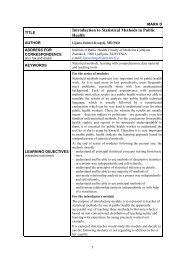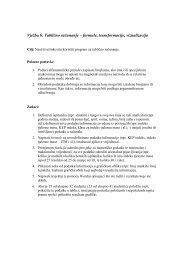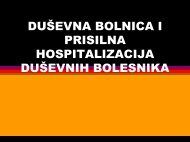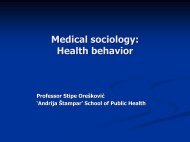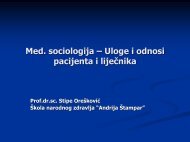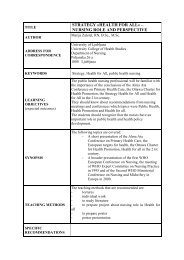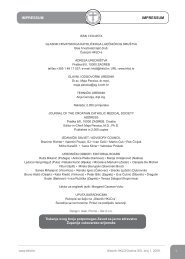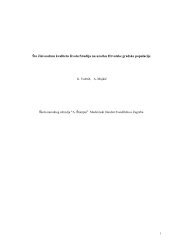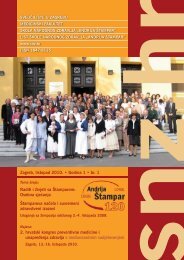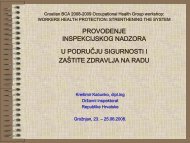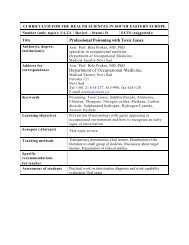STATISTINE METODE V EPIDEMIOLOGIJI
STATISTINE METODE V EPIDEMIOLOGIJI
STATISTINE METODE V EPIDEMIOLOGIJI
You also want an ePaper? Increase the reach of your titles
YUMPU automatically turns print PDFs into web optimized ePapers that Google loves.
One of the very important uses of this teaching method is in assessment<br />
how much students have learned and how comfortable they will be in using their<br />
knowledge in solving problems in the future.<br />
10. Role-playing (26,35,36).<br />
In role-playing, students are provided with a situation in which they are involved, and a<br />
role to play. They are asked to adopt a role, and play it. Afterwards they are required to<br />
debrief the experience, analysing the scenario, discuss their feelings, etc.<br />
This method is extremely helpful in gaining skills in interacting with other<br />
people, since it is an effective way to get students familiar with realistic situations. On<br />
the other hand, the major disadvantage is that shy students could find this method<br />
stressful. For overcoming this problem, a role is given to a group of students who work<br />
out the details, but the role is actually played only by one of them.<br />
Role-playing could be performed in small groups, as well as a frontal roleplaying<br />
in front of the total group.<br />
11. “Pro et contra” discussion (34,35).<br />
“Pro et contra” discussion is a special type of group discussion. It could be also<br />
partially seen as role playing.<br />
Two groups of students are given opposing positions to defend an opinion,<br />
standpoint, etc.<br />
12. Critical event analysis (35).<br />
This method is basing upon very concrete personal experience of students. Each student<br />
presents his/her concrete event, related to the topic under discussion. On the basis of<br />
personal story in the group discussion concrete solutions could be gained.<br />
Problem-Based Learning (PBL)<br />
PBL was originally developed at the Faculty of Health Sciences at McMaster University<br />
around 1965. PBL is an approach to learning and instruction in which students tackle<br />
problems in small groups under the supervision of a tutor. In most of the cases, a problem<br />
consists of a description of a set of phenomena or events than can be perceived in reality.<br />
These phenomena have to be analysed or explained by the tutorial group in terms of<br />
underlying principles, mechanisms or processes. The tools used in order to do that are<br />
discussion of the problem and studying relevant resources. Typically, tutorial groups<br />
range from 5 to 10 students and one tutor, who may not only be skilled in group process,<br />
but expert in content, or may be primarily a facilitator. (40,41)<br />
The core concept in PBL is that the process of problem identification and problem<br />
solving can be a powerful way of learning because it is active, goal directed, and<br />
germane. Problem identification opens the door to a personal investment in problemsolving.<br />
PBL has the following cognitive effects on student learning:<br />
• activation of prior knowledge – the initial analysis of a problem stimulates the<br />
retrieval of knowledge acquired earlier;<br />
• elaboration on prior knowledge through small group discussion, both before or<br />
after new knowledge has been acquired – active processing of new information;<br />
• restructuring of knowledge in order to fit the problem presented - construction<br />
of an appropriate semantic network.<br />
• learning in context. The problem serves as a scaffold for storing cues that may<br />
support retrieval of relevant knowledge when needed for similar problems.<br />
16



